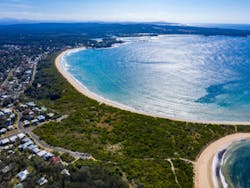Australian university studies possible network of coastal microgrids in New South Wales
A project led by the Australian National University (ANU) has selected eight sites on the New South Wales south coast for a deeper look into the feasibility of transitioning “at risk” regional communities to a network of islandable renewables and battery-based microgrids.
The Southcoast Microgrid Reliability Feasibility (SµRF) project, a recipient of federal funding under the previous government’s Regional and Remote Communities Reliability Fund, is examining the use of microgrids to bolster local energy resilience.
The project is being led by the Battery Storage and Grid Integration Program at ANU in partnership with the Southcoast Health and Sustainability Alliance (SHASA), network company Essential Energy and technology company Zepben.
It came about when SHASA approached the ANU in a bid to find solutions to the region’s “power vulnerability,” which had been brought into stark relief during the extreme bushfire season of 2019-20 in Australia.
This week, SµRF named eight sites in the NSW Eurobodalla Shire – Bodalla, Broulee, Central Tilba and Tilba Tilba (treated together), Congo, Mystery Bay, Nelligen, South Durras and Tuross Head – as the focus for further studies.
How the sites were chosen
The selected sites include small communities of less than 100 residents, medium townships of around 300 residents, and some of the region’s larger towns with roughly 2,000 residents.
Bjorn Sturmberg, technical lead on the SµRF project with the Battery Storage and Grid Integration Program at the ANU, said the goal was to choose sites that would best address the need to build resilience.
“To do this, we developed an integrated approach that sought to assess the vulnerability of communities based on socioeconomic factors, for example age or disability, as well as technical indicators such as historic data on power outages,” Sturmberg said.
“It also assessed the ease of implementing a microgrid based on the amount of rooftop solar already installed in each location.”
The team says the selected sites all rank highly in terms of vulnerability, as well as having high rates of solar installs and at least one microgrid option that is relatively tractable.
Also considered were issues like consultation fatigue – especially pertinent in the wake of the investigations into the Black Summer fires – cultural and ethnic diversity, and the layout of the town and electricity network.
On balance, the combination of the sites was also assessed to ensure the project could cover the diversity of the region and, as much as possible, reflect the broader diversity of regional Australia.
“Today’s announcement of the eight sites is a key milestone to progressing our understanding of how this may look in the future and, more importantly, to working with these local communities to learn how this type of technology may best support them,” said Essential Energy Chief Operating Officer Luke Jenner.
“Microgrids will undoubtedly form a part of our broader future network to help local communities work together to access more resilient, cleaner and cheaper energy.”
Benefits the coastal microgrids will provide
From here, the SµRF team will explore how the Eurobodalla could benefit from various microgrid designs, ranging from backup power for community shelters and essential services through to large systems servicing the whole of community.
Research will also weigh up policy and regulatory barriers to feasibility as well as other nontechnical factors that will play an important role in ensuring that grid-tied microgrids truly meet people’s needs and expectations.
Crucially, the project will seek input from residents, businesses and other groups in all eight communities to gauge their perspectives on different microgrid options and their preferences for how these systems could operate.
“We hope this approach inspires other regional projects, policymakers and funders to consider a wide range of factors in their efforts to boost resilience,” Sturmberg said.
This article originally appeared in One Step Off The Grid and was reposted with permission.
